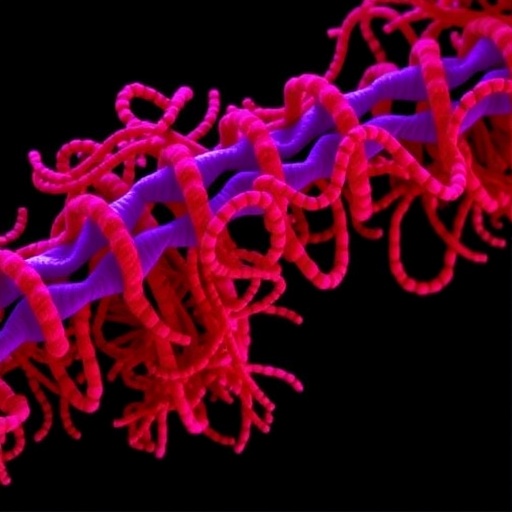In a groundbreaking study published in npj Viruses, researchers have unveiled the intricate molecular dialogue between Straboviridae bacteriophages and their bacterial hosts, shedding light on the sophisticated mechanisms by which viral adhesins engage with outer membrane proteins. Through meticulous structural and biochemical analyses, the team led by Lutz, Klein-Sousa, and Bojer has characterized how Gp38 adhesins, specialized viral attachment proteins, selectively recognize and bind to precise extracellular loops of bacterial outer membrane receptors. This discovery not only deepens our understanding of phage-host specificity but also opens new avenues for the design of phage-based antibacterial therapies.
Bacteriophages, or phages, are viruses that infect and invade bacterial cells, leveraging their host machinery to replicate. The infection process commences with the phage’s surface adhesins attaching to specific bacterial receptors, a crucial step determining host range and infection efficacy. The family Straboviridae, encompassing a diverse group of lytic phages, has been enigmatic in terms of the exact molecular interactions governing their attachment to Gram-negative bacteria. The current research addresses this gap by focusing on Gp38 adhesins, key viral proteins implicated in receptor binding.
Utilizing advanced cryo-electron microscopy (cryo-EM) combined with mutational mapping of bacterial receptor proteins, the study reveals that Gp38 adhesins engage in highly specific interactions with extracellular loops on outer membrane proteins (OMPs) of target bacteria. These loops protrude from the bacterial surface, serving as accessible binding sites. The fidelity of this binding determines phage infectivity, dictating which bacterial strains are vulnerable to particular Straboviridae phages. Notably, the binding involves a precise complementarity between the phage adhesin structure and the spatial conformation of the target loops.
The team employed recombinant expression systems to produce isolated Gp38 protein variants and synthetic bacterial OMP loop peptides. Surface plasmon resonance (SPR) and isothermal titration calorimetry (ITC) quantified the binding affinities, confirming the critical role of certain amino acid residues within the loops for high-affinity interactions. Mutagenesis experiments, where these residues were systematically altered, demonstrated a significant decrease or complete loss of phage adsorption, providing functional validation of the binding determinants.
Beyond structural insights, the research elucidates evolutionary aspects of phage-host interaction. Sequence comparisons across diverse Straboviridae Gp38 proteins reveal conserved motifs responsible for loop recognition, interspersed with variable regions likely enabling adaptation to different bacterial receptors. This balance of conservation and variability underpins the evolutionary arms race, whereby bacteria often modify surface loops to evade phage predation, while phages adapt their adhesins to regain infectivity.
The implications of these findings transcend basic virology. With the resurgence of antibiotic-resistant bacterial infections, phage therapy has reemerged as a promising alternative. Understanding the molecular basis of phage-host specificity is vital for engineering phages with targeted antibacterial activity. The detailed map of Gp38-OMP interactions provides a blueprint for designing synthetic adhesins or modifying natural ones to retarget phages against pathogenic bacteria expressing altered or novel surface proteins.
Moreover, the study indicates potential for using Gp38 adhesins as diagnostic tools. Because these proteins recognize unique extracellular loop conformations, they could be harnessed as molecular probes to detect specific bacterial strains in clinical or environmental settings. This specificity could improve bacterial typing and facilitate rapid identification of infectious agents, enhancing personalized treatment strategies.
Crucially, the research highlights the dynamic nature of outer membrane proteins in bacterial physiology. The loops targeted by phages often play roles in nutrient uptake, structural integrity, or immune evasion. Phage binding could, therefore, influence bacterial function beyond mere infection, possibly modulating bacterial behavior or fitness. Understanding these nuanced interactions might reveal new layers of complexity in microbial ecosystems and host-pathogen dynamics.
The methods applied in this study exemplify the power of interdisciplinary approaches. Integrating structural biology, microbiology, biophysics, and evolutionary bioinformatics enabled a comprehensive characterization of Gp38 adhesins. This multifaceted strategy facilitates not only the identification of binding sites but also the understanding of their functional and evolutionary context, underscoring the increasing sophistication in phage research methodologies.
Looking forward, the team envisions expanding their work to explore Gp38 interactions with a broader repertoire of bacterial receptors. Such studies would unravel the versatility and plasticity of phage adhesins, illuminating how these viruses navigate the complex topography of bacterial surfaces. Furthermore, in vivo investigations may elucidate how these molecular mechanisms translate into infection dynamics within natural bacterial communities or clinical infections.
The study also raises intriguing questions about the co-evolutionary pressures shaping bacterial membrane proteins. Since phage recognition depends on accessible extracellular loops, bacteria face trade-offs between mutating these loops to evade infection and preserving essential functions. This evolutionary tension likely drives diversity in both bacterial surface proteins and phage adhesins, contributing to the rich molecular interplay observed in microbial ecosystems.
Additional research inspired by these findings might focus on engineering synthetic phages equipped with designer Gp38 adhesins, tailored for targeted bacterial eradication. Such synthetic biology approaches could revolutionize antimicrobial strategies, offering precise and adaptable tools against resistant pathogens. The molecular resolution provided by this study lays the groundwork for these transformative applications.
In summary, the elucidation of Gp38 adhesin recognition of specific extracellular loops in bacterial OMPs represents a substantial advancement in viral attachment biology. This work not only deciphers the molecular underpinnings of Straboviridae phage specificity but also catalyzes future research spanning evolutionary biology, structural virology, and therapeutic innovation. As phage therapy continues to gain momentum, these insights will be critical to harnessing the full potential of bacteriophages in combating bacterial diseases.
Subject of Research:
The molecular mechanisms by which Gp38 adhesins of Straboviridae bacteriophages recognize and bind specific extracellular loops on bacterial outer membrane protein receptors.
Article Title:
Gp38 adhesins of Straboviridae phages recognize specific extracellular loops of outer membrane protein receptors.
Article References:
Lutz, V.T., Klein-Sousa, V., Bojer, M.S. et al. Gp38 adhesins of Straboviridae phages recognize specific extracellular loops of outer membrane protein receptors. npj Viruses 3, 37 (2025). https://doi.org/10.1038/s44298-025-00118-9
Image Credits:
AI Generated




